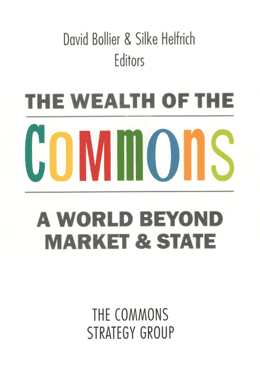| | The For-Profit Paradigm | The Commons Paradigm |
| Resources | Scarcity is given or created (through barriers and exclusions). | For rivalrous resources, there is enough for all through sharing.
For non-rivalrous resources, there is abundance. |
| | Strategy: “Efficient” resource allocation. | Strategy: Strengthening social relations is decisive for assuring fair shares and sustainable use of resources. |
| Idea of the individual | Individuals maximize benefits for themselves (Homo economicus). | Humans are primarily cooperative social beings. |
| Human relationships to nature and other humans | Separation
- Either/or
- Individualism vs. collectivism
- Human society vs. Nature
| Interrelationality
- Individuals and the collective are nested within each other and mutually reinforcing.
|
| Change agents | Powerful political lobbies, interest groups and institutionalized politics focused on government. | Diverse communities working as distributed networks, with solutions coming from the margins. |
| Focus | Market exchange and growth (GDP) achieved through individual initiative, innovation and “efficiency.” | Use-value, common wealth, sustainable livelihoods and complementarity of enterprise. |
| Core question | What can be sold and bought? | What do I / we need to live? |
| GOVERNANCE |
| Decision making | Hierarchical, top-down; command & control | Horizontal, decentralized, bottom-up. Self-organization, monitoring and adjustment of resource use. |
| Decision principle | Majority rules. | Consensus. |
| SOCIAL RELATIONSHIP |
| Power relation tendency | Centralization & monopoly. | Decentralization & collaboration. |
| Exclusive private property.
“I can do what I want with what is mine.” | Collectively used possession.
“I am co-responsible for what I co-use.” |
Access to rival resources (land, water, forest) | Limited access; rules defined by owner. | Limited access; rules defined by users. |
Access to non- rival resources (ideas, code...) | Limited access; scarcity is artificially created through law and technology. | Unlimited access; open access is the default norm. |
| Granted by owner (or not). Focus on: individual rights. | Co-decided by co-producing users. Focus on: fairness, access for all. |
| Prevail at the expense of others; competition dominates. | Commoning; cooperation dominates |
|
| | Corporate ideology and values integrated into education and knowledge production. | Peer-to-peer, networking and collaboration allows diversity of viewpoints. |
| | Knowledge regarded as scarce asset to be bought and sold. | Knowledge regarded as plentiful resource for the common good of society. |
| | Proprietary technologies. | Free and open source technologies. |
| | Highly specialized knowledge and expertise are privileged. | Knowledge is subject to social and democratic control. |
|
| Depletion/exploitation. Enclosure. | Conservation / maintenance. Reproduction & expansion. |
| Individual appropriation vs. collective interests. Exclusion. | “My personal unfolding is a condition for the development of others, and vice- versa.” Emancipation through convivial connections. |
 Buy at Levellers Press
Buy at Levellers Press 